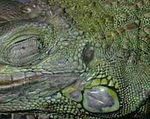| This article is still under construction. |
Most of the lizards seem to hear in the same range as the green iguana (500 to 4,000Hz range), with a sensitivity peak at 700 Hz, equal to about 24 dB. For lizards lacking a tympanic membrane, such as the lesser (Northern) earless lizard (Holbrookia maculata) and many fossorial (burrowing) and semi-fossorial lizards (for example the legless Anniella), hearing is limited to lower frequencies.
Gekkonids who vocalize have both high sensitivity and high frequency, up into the 10,000Hz range.
Anatomy
The lizard ear has auditory and vestibular functions. In many lizards the external ear is greatly reduced and most species have a superficial tympanum. Exceptions include geckos and monitors which have external ear canals. Iguanids have a tympanic membrane which is nearly contiguous to the surface of the skin whereas it is deeper and recessed in scincids (such as the blue-tongue skink) and agamids (such as the bearded dragon).
Lizards have middle and inner ears; the tympanic membrane covers the middle ear cavity which is linked to the pharynx and eustachian tube. In general, the inner boundary of the middle ear cavity has two openings: a round one, covered by a thin membrane, and an oval opening that is uncovered.
The stapes (or stirrup) is a single bone that connects the eardrum to the inner ear; it crosses the middle ear cavity, from the inside of the tympanic membrane, its inner end fitted inside the oval opening. The outer end of the stapes has a cartilage cap which comes into contact with the tympanic membrane. In some reptiles, this cartilage, called the extrastapes, is attached to the quadrate, the primary support of the lower jaw. The upper and lower jaws contain several bones not found in mammals.
The inner ear cavity comprises organs related to balance (the semicircular canals, utricle, and saccule) and hearing (cochlear duct). The cochlear duct and the saccule are both suspended in perilymphatic fluid; the cochlear is also filled with this fluid.
There is a single ossicle, the columella.
